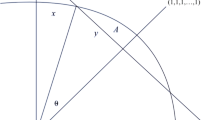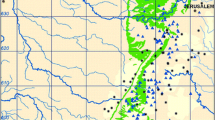Abstract
In this paper, hierarchical and non-hierarchical tree structures are proposed as models of similarity data. Trees are viewed as intermediate between multidimensional scaling and simple clustering. Procedures are discussed for fitting both types of trees to data. The concept of multiple tree structures shows great promise for analyzing more complex data. Hybrid models in which multiple trees and other discrete structures are combined with continuous dimensions are discussed. Examples of the use of multiple tree structures and hybrid models are given. Extensions to the analysis of individual differences are suggested.
Similar content being viewed by others
Reference notes
Carroll, J. D., and Pruzansky, S. Fitting of hierarchical tree structure (HTS) models, mixtures of HTS models, and hybrid models, via mathematical programming and alternating least squares. Presented at theU.S.-Japan Seminar on Theory, Methods, and Applications of Multidimensional Scaling and related techniques, San Diego, Aug. 1975. Paper in informally published Proceedings of U.S.-Japan Seminar, available on request.
Cunningham, J. P. On finding an optimal tree realization of a proximity matrix. Paper presented at the Mathematical Psychology meeting, Ann Arbor, Michigan, August 29, 1974.
Harshman, R. A. PARAFAC2: Mathematical and technical notes (Working Papers in Phonetics No. 22). Los Angeles: University of California, March, 1972.
Kruskal, Joseph B. Some advances in parametric mapping. Psychometric Society Presidential Address, presented at joint meeting of Psychometric Society and Classification Society, Iowa City, Iowa, April, 1975.
Sattath, S. and Tversky, A. Additive similarity trees. Unpublished manuscript, Hebrew University, 1976.
Shepard, R. N. and Arabie, P. Additive cluster analysis of similarity data. Paper presented at the U.S.-Japan Seminar on Theory, Methods, and Applications of Multidimensional Scaling and Related Techniques, San Diego, 1975. Paper in informally published Proceedings of U.S.-Japan Seminar.
Tversky, A. Features of similarity. Unpublished manuscript, Hebrew University, Jerusalem, Israel, 1976.
References
Buneman, P. The recovery of trees from measures of dissimilarity. In F. R. Hodson' D. G. Kendall and P. Tautu (Eds.),Mathematics in the archaeological and histroical sciences. Edinburgh: Edinburgh University Press, 1971, 387–395.
Carroll, J. D., and Chang, J. J. Analysis of individual differences in multidimensional scaling via an N-way generalization of “Eckart-Young” decomposition.Psychometrika, 1970,35, 283–319.
Carroll, J. D. and Chang, J. J. A method for fitting a class of hierarchical tree structure models to dissimilarities data and its application to some “body parts” data of Miller's.Proceedings of the 81st Annual Convention of the American Psychological Association, 1973,8, 1097–1098.
Degerman, R. Multidimensional analysis of complex structure: Mixtures of class and quantitative variation.Psychometrika, 1970,35, 475–491.
de Leeuw, J., Young, F. W. and Takane, Y. Additive structure in qualitative data: An alternating least squares method with optimal scaling features.Psychometrika, 1976, 000-000.
Dobson, J. Unrooted trees for numerical taxonomy.Journal of Applied Probability, 1974,11, 32–42.
Hartigan, J. A. Representation of similarity matrices by trees.Journal of the American Statistical Association, 1967,62, 1140–1158.
Holman, E. W. The relation between hierarchical and Euclidean models for psychological distances.Psychometrika, 1972,37, 417–423.
Horan, C. B. Multidimensional scaling: Combining observations when individuals have different perceptual structures.Psychometrika, 1960,34, 139–165.
Johnson, S. C. Hierarchical clustering schemes.Psychometrika, 1967,32, 241–254.
Miller, G. A. A psychological method to investigate verbal concepts.Journal of Mathematical Psychology, 1969,6, 169–191.
Patrinos, A. N. and Hakimi, S. L. The distance matrix of a graph and its tree realization.Quarterly of Applied Mathematics, 1972,30, 255–269.
Romney, A. K. and D'Andrade, R. G. Cognitive aspects of English kin terms.American Anthropologist, 1964,66, No. 3, part 2 (special publication), 146–170.
Rosenberg, S. and Kim, M. P. The method of sorting as a data-gathering procedure in multivariate research.Multivariate Behavioral Research, 1975,10, 489–502.
Shepard, R. N. Representation of structure in similarity data: Problems and prospects.Psychometrika, 1974,39, 373–421.
Torgerson, W. S. Multidimensional scaling of similarity.Psychometrika, 1965,30, 379–393.
Tucker, L. R. Relations between multidimensional scaling and three-mode factor analysis.Psychometrika, 1972,37, 3–27.
Wish, M., Kaplan, S. J. and Deutsch, M. Dimensions of interpersonal relations: Preliminary results.Proceedings of the 81st Annual Convention of the American Psychological Association, 1973,8, 179–180.
Wish, M. Comparisons among multidimensional structures of interpersonal relations.Multivariate Behavioral Research, in press.
Wold, H. Estimation of principal components and related models by iterative least squares. In P. R. Krishnaiah (Ed.),Multivariate Analysis. New York: Academic Press, 1966.
Author information
Authors and Affiliations
Additional information
1976 Psychometric Society Presidential Address.
While people too numerous to list here have contributed ideas, inspiration, and other help, I particularly wish to acknowledge the contributions of Sandra Pruzansky, without whom this paper could not have been written. I would also like to acknowledge the past contributions of my long-time colleague Jih-Jie Chang, without whose help I probably would not have beenasked to write it.
Rights and permissions
About this article
Cite this article
Carroll, J.D. Spatial, non-spatial and hybrid models for scaling. Psychometrika 41, 439–463 (1976). https://doi.org/10.1007/BF02296969
Issue Date:
DOI: https://doi.org/10.1007/BF02296969




